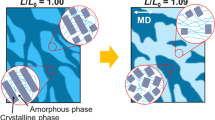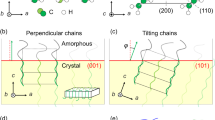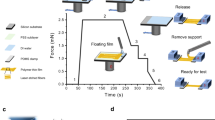Abstract
A new polarized microwave method for determining the orientation of polymer molecules in films without contact and its application to poly(ethylene terephthalate) (PET) are presented. The angular dependence of transmitted microwave intensity allowed the orientation angle, the maximum to minimum intensity ratio, and the ratio of intensities in the transverse to the machine direction to be determined in as a short time as ca. 30 s. The maximum to minimum intensity ratio for uniaxially stretched PET increased with increasing draw ratio. The unstretched and uniaxially and biaxially stretched PET showed orientation patterns different in the angular dependence of transmitted microwave intensity. With the results obtained from X-ray diffraction, mechanical breaking strength, infrared absorption, refractive index, and thermal shrinkage measurements, it was concluded that the orientation angle and the maximum to minimum ratio determined by the microwave method reflect, respectively, the direction and the degree of the orientation of PET chains. Biaxially stretched PET gave different orientation patterns at different positions in the transverse direction. It was found that results from the microwave method give information on the dielectric anisotropy of films and depend on machine condition in preparing films.
Similar content being viewed by others
Article PDF
References
I. M. Ward, “Structure and Properties of Oriented Polymers,” Applied Science, London, 1975.
I. M. Ward, “Development in Oriented Polymers-1,” Applied Science, London, 1982.
S. Osaki, TAPPI J., 70, 105 (1987).
K. Yamafuji and Y. Ishida, Kolloid-Z.Z. Polym., 183, 15 (1962).
Y. Ishida, J. Polym. Sci., A-2, 7, 1835 (1969).
T. M. Shaw and J. J. Windle, J. Appl. Phys., 21, 956 (1950).
K. K. S. Jamawl and A. Dhar, Rev. Sci. Instrum., 52, 767 (1981).
N. G. McGraw, R. E. Reed, and G. Williams, “Anelastic and Dielectric Effects in Polymeric Solids,” John Wiley, New York, N. Y., 1967.
S. Osaki, S. Uemura, and Y. Ishida, J. Polym. Sci., A-2, 9, 585 (1971).
S. Osaki and T. Kotaka, Ferroelectrics, 32, 1 (1981).
S. Osaki and Y. Ishida, J. Polym. Sci., A-2, 12, 1727 (1974).
H. Kakutani, J. Polym. Sci., A-2, 8, 1177 (1970).
E. L. Ginzton, “Microwave Measurements,” McGraw-Hill, New York, N. Y., 1957.
W. H. Cobbs, Jr., and R. L. Burton, J. Polym. Sci., 10, 275 (1953).
A. Miyake, J. Polym. Sci., 38, 479 (1959).
Author information
Authors and Affiliations
Rights and permissions
About this article
Cite this article
Osaki, S. A New Method for Quick Determination of Molecular Orientation in Poly(ethylene terephthalate) Films by Use of Polarized Microwaves. Polym J 19, 821–828 (1987). https://doi.org/10.1295/polymj.19.821
Issue Date:
DOI: https://doi.org/10.1295/polymj.19.821
Keywords
This article is cited by
-
Orientation test
Nature (1990)



